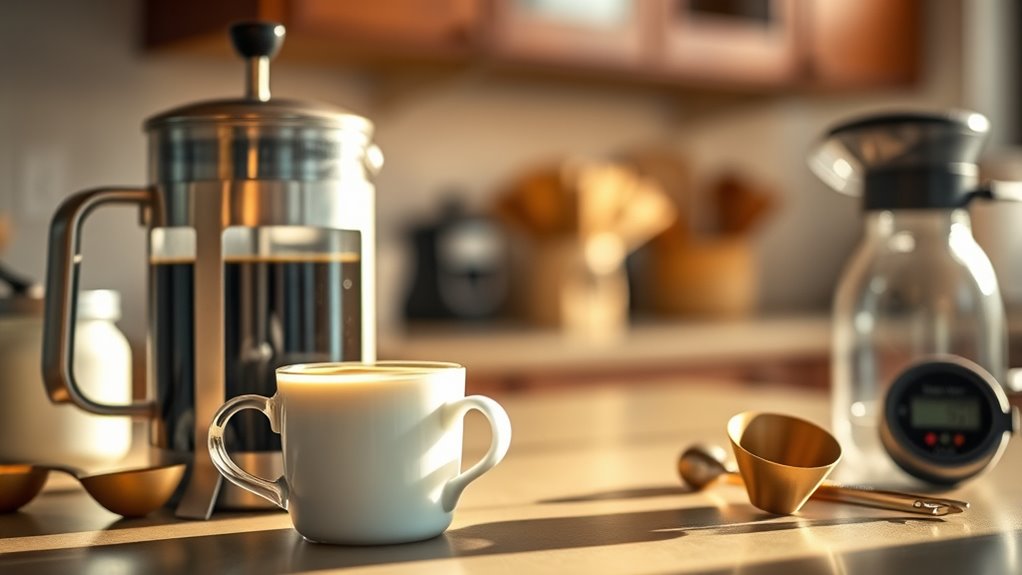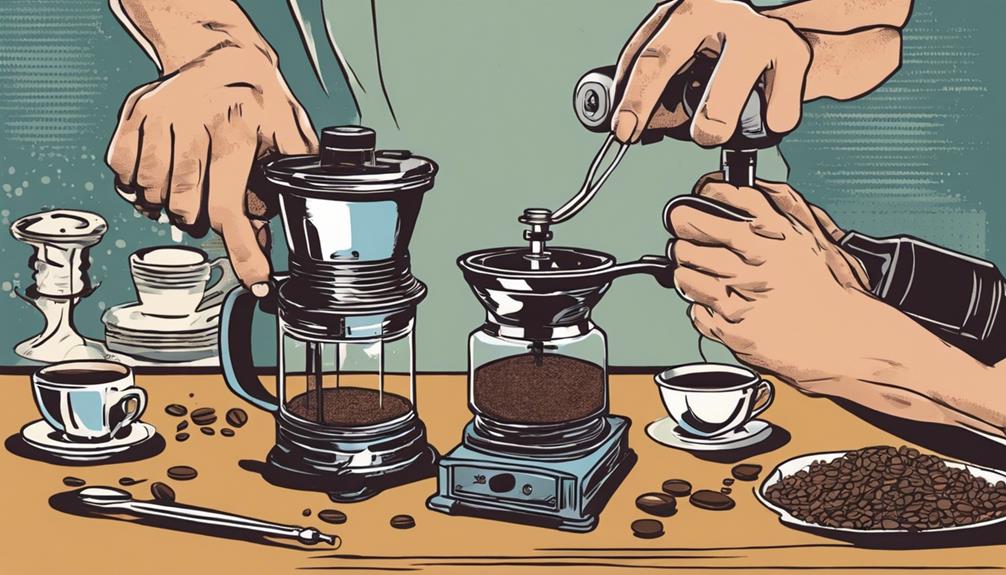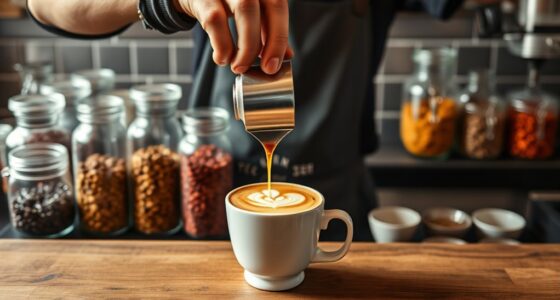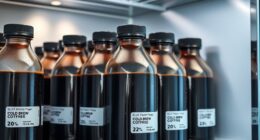To brew better coffee at home, start with freshly roasted beans and grind them just before brewing using a burr grinder for uniform grounds. Use a precise coffee-to-water ratio of 1:15 to 1:17, and guarantee you’re using filtered water heated to about 195–205°F. Experiment with different brewing times and methods to find what suits your taste. Small tweaks can make a big difference—keep exploring to reveal even richer flavors.
Key Takeaways
- Use freshly roasted beans and grind them just before brewing for maximum aroma and flavor.
- Measure coffee grounds precisely with a digital scale and maintain a consistent coffee-to-water ratio.
- Use filtered water heated to 195–205°F for optimal extraction and flavor clarity.
- Choose the appropriate brewing method and adjust brew time for balanced, flavorful results.
- Experiment with grind size, water temperature, and timing to personalize and enhance your coffee at home.
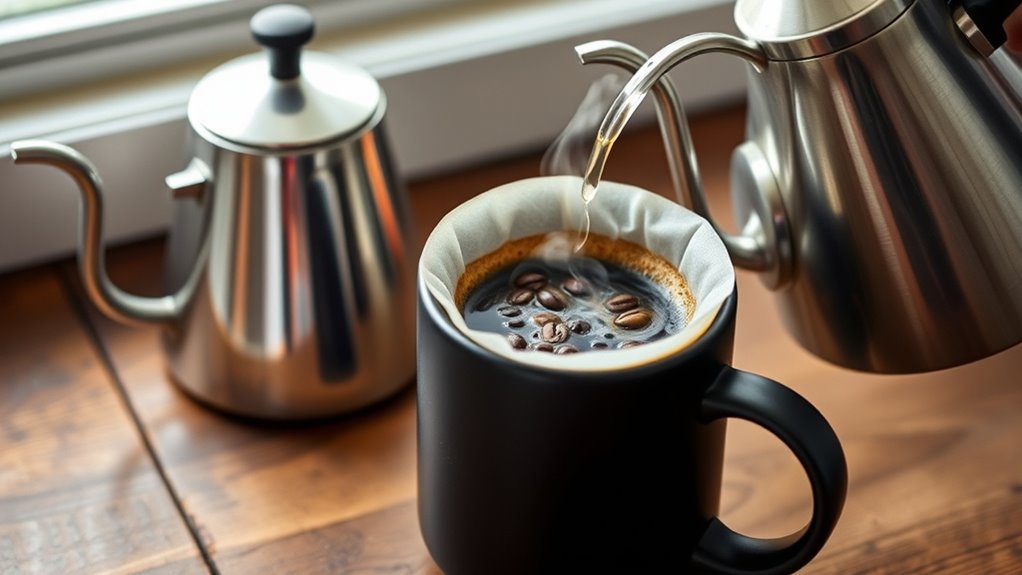
Enjoying great coffee at home starts with paying attention to the details. The foundation of a flavorful cup begins with using freshly roasted coffee beans. These beans are packed with aroma and essential oils that degrade over time, so grinding them just before brewing ensures you capture maximum freshness and flavor.
To get consistent results, measure your coffee grounds by weight. Using a digital scale helps you achieve the ideal ratio of coffee to water, typically between 1:15 and 1:17, which provides a balanced strength without being too weak or overpowering.
The grind size is vital for a proper brew. Invest in a burr grinder, which produces uniform coffee grounds, leading to more even extraction. A consistent grind size ensures that hot water interacts uniformly with the coffee grounds, extracting flavor evenly and preventing over or under-extraction.
Whether you’re using a pour-over, French press, or drip machine, adjusting the grind size according to your brewing method will markedly impact the final taste. Finer grounds are suitable for espresso, while coarser grounds work better for French press or cold brew.
Next, pay attention to your water. Filtered water heated to about 195–205°F is ideal for brewing. Using filtered water enhances flavor clarity and prevents off-flavors that can come from tap or distilled water.
Hot water extracts the coffee’s soluble compounds efficiently, resulting in a more vibrant, flavorful cup. When you pour the hot water over your coffee grounds, ensure even saturation to promote proper extraction.
The brewing process, whether it’s pour-over or immersion, should be carefully timed to optimize flavor without over-extracting bitter compounds.
Experimenting with brewing variables—like grind size, water temperature, and brew time—allows you to tailor your coffee to your personal taste. Adjusting these factors can bring out different flavor notes, from bright and acidic to rich and full-bodied.
Frequently Asked Questions
How Do I Make My Coffee Taste Better at Home?
To make your coffee taste better at home, start with freshly roasted, whole beans and grind them just before brewing to lock in flavor.
Use a precise scale to measure coffee and water, aiming for a 1:15 to 1:17 ratio.
Brew with filtered water at 195–205°F, and consider experimenting with different methods like pour-over or AeroPress.
Adding spices, citrus zest, or milk froth can also boost flavor and enjoyment.
What Is the 80/20 Rule for Coffee?
The 80/20 rule for coffee means that 80% of the flavor comes from just 20% of the brewing variables. You should focus on high-quality, fresh beans and precise grind size, as these make the biggest difference.
Small tweaks like water temperature or brew time also matter. By prioritizing these key factors, you’ll improve your coffee’s taste markedly with minimal effort.
What Is the 15-15-15 Coffee Rule?
The 15-15-15 coffee rule guides you to use 15 grams of coffee, 15 grams of water, and brew for 15 seconds. This method helps you achieve a balanced, flavorful shot by emphasizing precise measurements and a short extraction time.
It’s especially useful for beginners because it encourages consistency and control. You can tweak these parameters to suit your taste or equipment, but the core idea is balance and precision.
Why Does My Coffee Not Taste Good at Home?
Your coffee mightn’t taste good at home because you’re likely using stale beans that have lost flavor, or your grinder produces uneven grounds, leading to poor extraction.
Poor-quality water or incorrect brewing temperatures can also spoil the taste. Additionally, not measuring your coffee and water accurately can result in an imbalanced flavor.
Focus on using fresh beans, a good grinder, filtered water, proper temperature, and precise measurements to improve your coffee’s flavor.
Conclusion
By trying these tips, you’ll notice a real difference in your coffee experience. From choosing fresh beans to perfecting your brewing method, small changes can make a big impact. Keep experimenting and paying attention to details like grind size and water temperature. With a little practice, you’ll brew better, richer coffee right at home every day. Enjoy the process and savor every sip—your perfect cup is just a few tweaks away!
